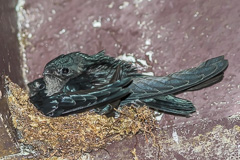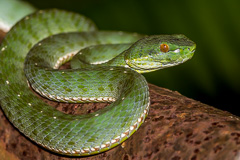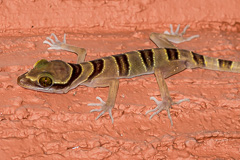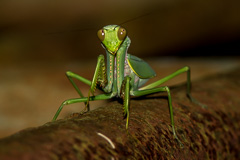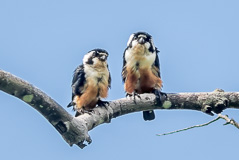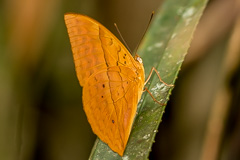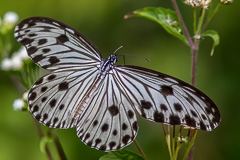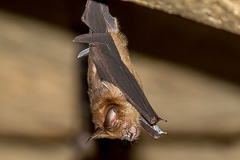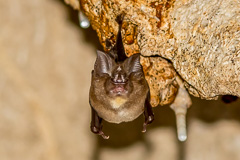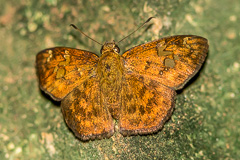Overview
Dates: |
2 - 9 July 2015 |
With Ian Dugdale plus, in part, Games Punjapa Phetsri and Paul Carter. Birding at any altitude above 400 metres in southern Thailand is nigh-on impossible without major logistical issues. So having discovered recently the possibility of being able to drive to almost 1,000 metres altitude to the top of Khao Ramrom in Nakhon Sri Thammarat province, we decided to investigate. An internet search and questions to other resident birders revealed, surprisingly, that the mountain has never been explored ornithologically. Two southern mountain specialities are known from the nearby Khao Luang: Malayan Laughingthrush and Turquoise-throated Barbet - the endemic chersonesus race of Blue-throated Barbet. These occur at over 1,000 metres and 900 metres respectively, so we considered the barbet to be a distinct possibility, added to which investigation of new sites is always interesting and worthwhile. We were aware that the mountain might be good for butterflies.
2 Jul. Took Air Asia from Chiang Mai to Phuket, arriving ahead of schedule at 14:25. Met up with Ian and drove the three plus hours to Ron Phibun, from where we headed directly up the mountain. We were rather surprised to discover that the road, although very steep and narrow, is actually paved all the way to the top. This no doubt is due to there being several TV relay stations at the summit. As the area officially lies within the Namtok Yong National Park we'd already made reservations to stay at the park accommodation close to the summit. The bungalows have great views and the location is very peaceful and cool. Typically though of national park accommodation the 1,000 Baht/night is overpriced for the facilities provided - cold showers and rock hard beds included. In theory a one way traffic system operates on the summit road. Going up on the hour and down on the half hour. However, being so little traffic this seemed largely ignored. We hardly saw any staff at the park, but those we did were helpful and friendly. In the last half hour of light we took a wander up the road to the TV stations at the summit, finding Plume-toed Swiftlet and Crimson Sunbird. As no food is available in the park, we dined alone on the patio accompanied by an excellent collection of visiting moth species. A night walk produced Thai Peninsula Pit Viper and Beautiful Bent-toed Gecko. 3 Jul. A very windy night with many outside items taking off in the wind. At sunrise still cloudy and gusty and not at all conducive to good birding. Following breakfast we walked the road, both up to the summit and down as far as 800 metres altitude. A few interesting butterflies plus Orange-breasted Trogon, Brown-cheeked Fulvetta, Red-throated Barbet, Blue-eared Barbet and some immature Cyornis flycatchers, assumed to be resident Hill Blue Flycatcher based on altitude. No sign of either of our target species. A longer walk along the 600 metre Nature Trail, produced little other than many leeches. Following lunch, another walk around the top section but again high winds and cloud kept activity low. Despite the wind, at nightfall we had another splendid collection of moths around the accommodation, followed by another night walk, but with only a large mantis found. |
4 Jul. Another gale overnight, with lower cloud and stronger winds than yesterday by daybreak. A short walk to the top, that we measured at 980 metres, revealed little so we headed down slowly as far as about 700 metres adding a few new bird species for the area including Black-thighed Falconet. With improving weather and sun, some good butterflies late morning. Lunch was interrupted by deteriorating weather with strong winds and horizontal rain, so retreated to our accommodation for a couple of hours. When eventually the weather cleared we headed downhill to continue where we'd left off at 700 metres earlier. |
However, no sooner had we arrived than rain started again, forcing a retreat. No night walk due to increasingly strong winds, low cloud and drizzle.
5 Jul. Another night of howling winds, impressive enough to flatten the tents in the campsite, so we decided to forego the upper stretches early morning and head down to 700 metres. Although early conditions did not look particularly good for butterflies we found a few interesting species including Spotted Spark. We also added Greater Coucal and Crested Serpent Eagle to the bird list, bringing our total trip list to a very unimpressive 35 species. Birding on Khao Ramrom is hard going! We left the area around 10:00, drove to collect Games and continued to Satun, arriving late afternoon. Overnight in roadside accommodation outside town.
6 Jul. Most of the day, until about 17:00 spent in Thaleban National Park. Best birds of the day were Red-bearded Bee-eater, Blue-crowned Hanging Parrot, Black-and-yellow Broadbill and a single Malayan Swamp Babbler. Late afternoon drive to Trang and an overnight in the city.
7 Jul. Rain, sometimes heavy continuing into the morning. Despite the weather, we decided to try Khao Chong Botanical Garden about ten kilometres from the city, with the idea to check out habitat for Chestnut-capped Thrush. Light rain ceased shortly after arrival so we set out on one of the short forest trails. Twenty minutes later we were caught out in a heavy downpour that we suffered for another half hour before deciding to throw in the towel and head north to Ao Leuk. The whole 200 plus kilometre drive was through grey overcast conditions with some heavy rain, so seemed we'd made the correct decision to leave. Met up with Paul for a couple of days of caves and mammal exploration. Mid to late afternoon we explored Khao Phra and Khao Rang caves. Bats were the main target with us finding Lesser False Vampire Bat, Pendlebury's Roundleaf Bat and Great Roundleaf Bat. Dinner in town followed by a night return to the field where in three hours we found a mixed bag, including a point blank Oriental Bay Owl, Eastern Barn Owl, Grass Frog and Grey Water Snake. Overnight near Ao Leuk town. 8 Jul. We started at Phet Cave, which we found of great interest. In the maybe 300 metres of navigable cave we had at least two bat species plus assorted crickets and spiders. Outside we found Cave Racer, Blue-winged Pitta and Pseudocoladenia fabia. Following lunch at a simple roadside restaurant we checked out Sa Yuan Thong Cave. Very disappointing, with limited accessibility and a trashed environment - one to be avoided. Embarrassing that this cave actually lies within the Than Bok Khorani National Park. Mid afternoon we visited Khlang Cave, but found it officially closed for repair of facilities and boardwalks. However, on asking about access we were able to enter with a local guide, who proved to be experienced and competent. We certainly found the walkways in a precarious state and were glad of the guide as without we'd never have been able to navigate inside this interesting cave complex. We'd probably have been able to navigate in, but almost certainly would have got lost trying to return such was the complexity of the formations and passageways. We encountered two new bat species. Surprisingly dry all day, and another night session produced three species of frog, another Grey Water Snake and a Brown Wood Owl. 9 Jul. A return to the Phet Cave area where we decided to circumnavigate the whole limestone karst mountain birding forest edge. Although we didn't encounter anything unexpected, a good number of Blue-winged Pitta and a Crimson Sunbird were notable. Several spectacular butterflies also seen including Plush and Siam Jungleglory. Afternoon return to Phuket and subsequent flight to Chiang Mai. |
Species List
| Khao Ramrom | Count | Thaleban | Count | ||
| Crested Honey Buzzard | 1 | Crested Serpent Eagle | 1 | ||
| Crested Serpent Eagle | 1 | Grey-rumped Treeswift | 10 | ||
| Common Emerald Dove | 1 | Edible-nest Swiftlet | 6 | ||
| Greater Coucal | 2 | Asian Palm Swift | 6 | ||
| Green-billed Malkoha | 2 | House Swift | 3 | ||
| Banded Bay Cuckoo | 1 | Red-bearded Bee-eater | 1 | ||
| Plume-toed Swiftlet | 40 | Blue-crowned Hanging Parrot | 2 | ||
| Edible-nest Swiftlet | 4 | Black-and-yellow Broadbill | 3 | ||
| Orange-breasted Trogon | 1 | Scarlet Minivet | 4 | ||
| Golden-whiskered Barbet | 1 | Large-billed Crow | 2 | ||
| Red-throated Barbet | 5 | Black-crested Bulbul | 2 | ||
| Blue-eared Barbet | 3 | Yellow-vented Bulbul | 2 | ||
| Black-thighed Falconet | 2 | Asian Red-eyed Bulbul | 3 | ||
| White-bellied Erpornis | 2 | Rufous-bellied Swallow | 4 | ||
| Blyth's Paradise Flycatcher | 1 | Rufous-tailed Tailorbird | 1 | ||
| Grey-headed Canary-flycatcher | 2 | Malayan Swamp Babbler | 1 | ||
| Black-headed Bulbul | 2 | Grey-breasted Spiderhunter | 2 | ||
| Black-crested Bulbul | 1 | ||||
| Stripe-throated Bulbul | 6 | Than Bok Khorani | Count | ||
| Asian Red-eyed Bulbul | 2 | Spotted Dove | 6 | ||
| Ochraceous Bulbul | 2 | Zebra Dove | 10 | ||
| Hairy-backed Bulbul | 1 | Greater Coucal | 4 | ||
| Cinereous Bulbul | 2 | Eastern Barn Owl | 2 | ||
| Barn Swallow | 1 | Oriental Bay Owl | 2 | ||
| Yellow-bellied Warbler | 4 | Brown Wood Owl | 1 | ||
| Dark-necked Tailorbird | 5 | Edible-nest Swiftlet | 4 | ||
| Grey-throated Babbler | 2 | Asian Palm Swift | 2 | ||
| Pin-striped Tit-Babbler | 10 | House Swift | 40 | ||
| Brown-cheeked Fulvetta | 4 | White-throated Kingfisher | 6 | ||
| Asian Fairy-bluebird | 3 | Red-throated Barbet | 3 | ||
| Hill Blue Flycatcher | 3 | Blue-eared Barbet | 2 | ||
| Crimson-breasted Flowerpecker | 1 | Coppersmith Barbet | 1 | ||
| Orange-bellied Flowerpecker | 4 | Blue-winged Pitta | 8 | ||
| Crimson Sunbird | 3 | Stripe-throated Bulbul | 2 | ||
| Little Spiderhunter | 2 | Streak-eared Bulbul | 5 | ||
| Rufous-bellied Swallow | 20 | ||||
| Rufescent Prinia | 2 | ||||
| Common Tailorbird | 2 | ||||
| Common Myna | 20 | ||||
| Oriental Magpie-Robin | 3 | ||||
| Blue Whistling Thrush | 6 | ||||
| Blue Rock Thrush | 2 | ||||
| Ruby-cheeked Sunbird | 5 | ||||
| Crimson Sunbird | 1 |

